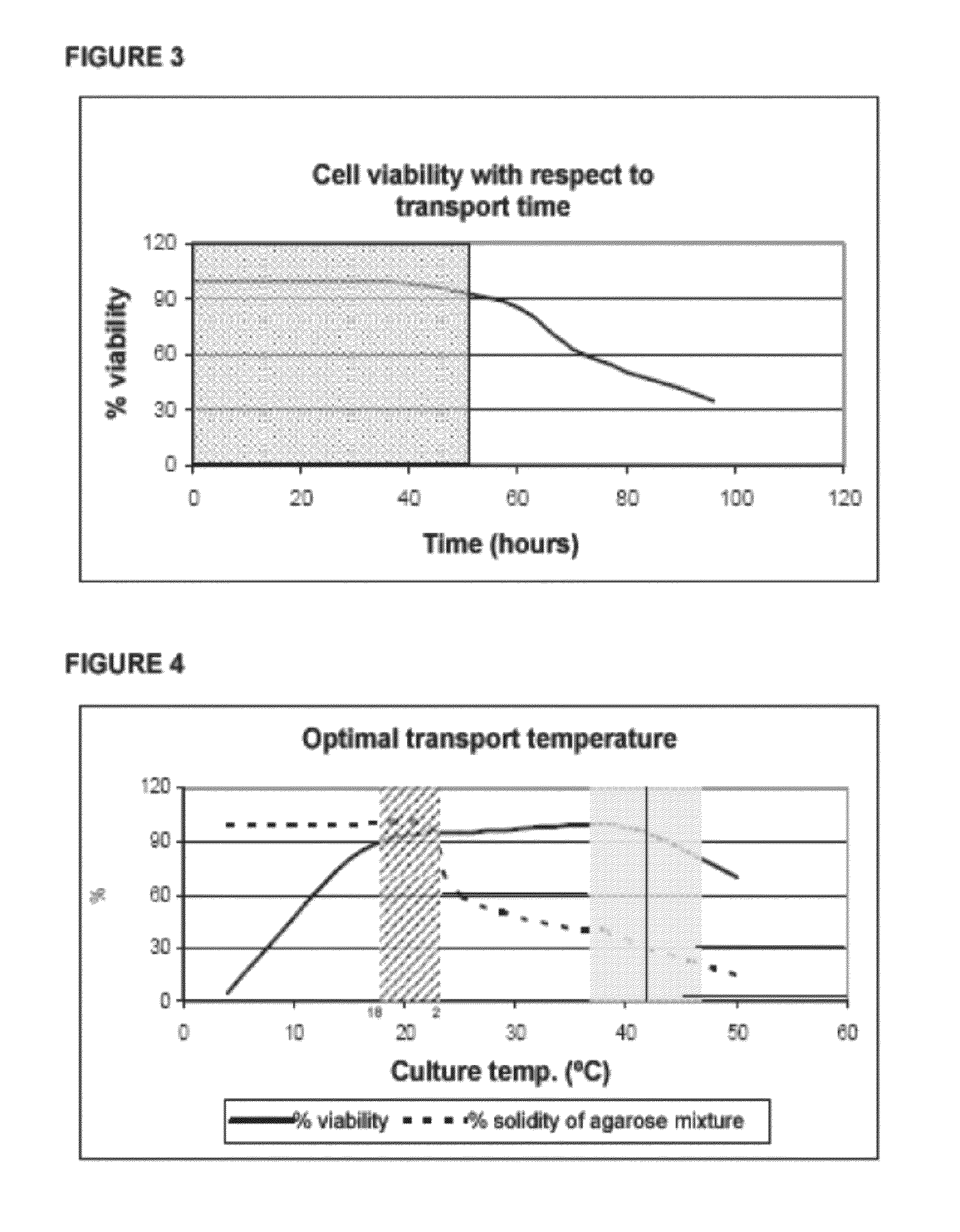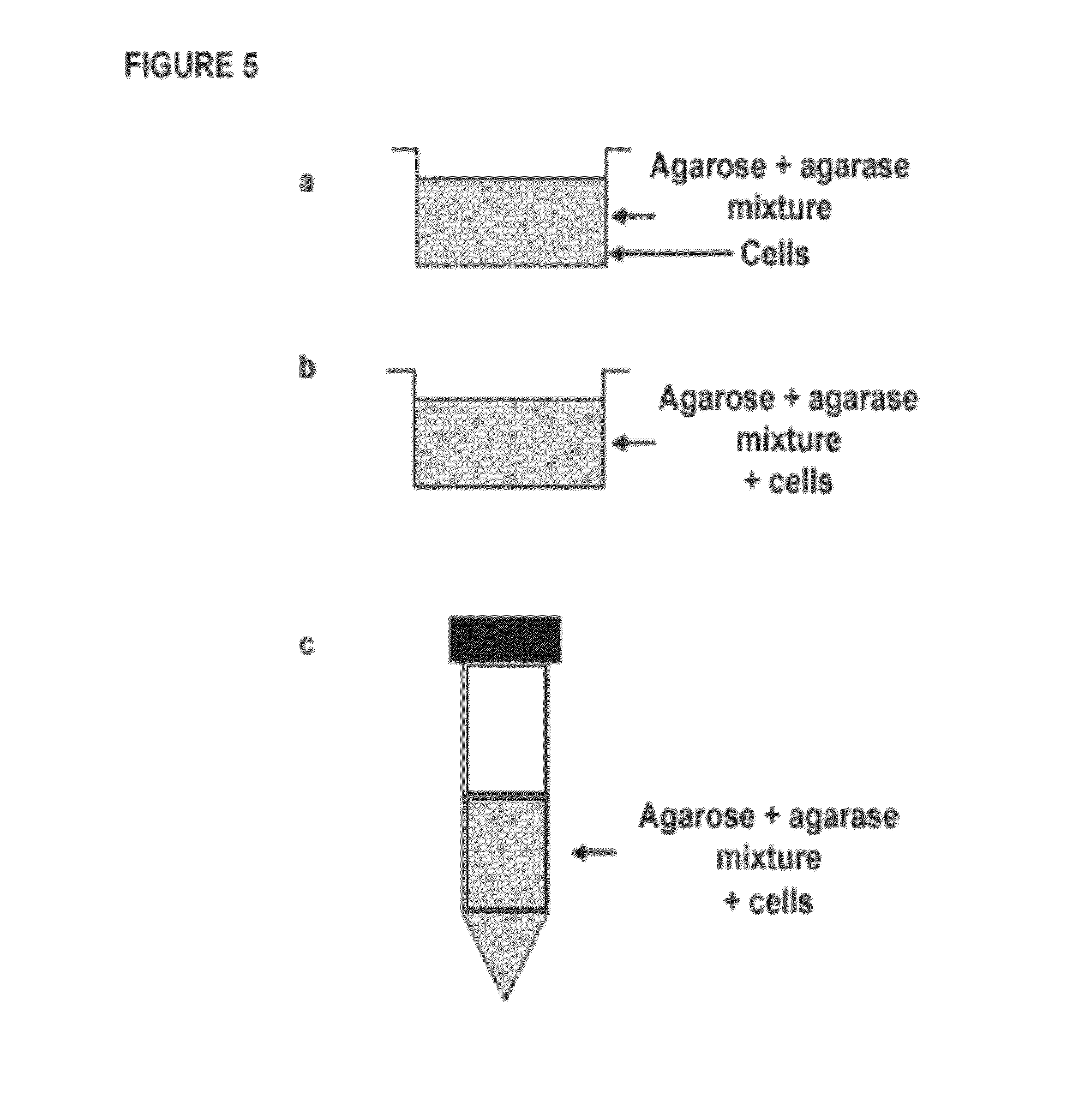Cell transport system comprising a homogeneous mixture of agarose and agarase
a cell transport system and homogeneous mixture technology, applied in the field of cell transport systems, can solve the problems of difficult to maintain the entire transport time, and tedious manipulation, and achieve the effect of optimizing the recovery of cells
- Summary
- Abstract
- Description
- Claims
- Application Information
AI Technical Summary
Benefits of technology
Problems solved by technology
Method used
Image
Examples
example 1
Determining the Ranges of Agarose and Agarase in the Transport System
[0204]1.1 Determining the Final Agarose Concentration in the System
[0205]Taking into account that each of the types or cell lines requires the use of a different and specific culture medium, and that the properties of the different culture media differ from one another, and on many occasions commercially prepared culture media do not provide the information necessary for identifying the specific characteristics of the medium, it is necessary to empirically verify in each of the culture media to be transported the final agarose concentration necessary for applying the transport system of the present invention.
[0206]To determine the final agarose concentration range that will be used in the system, a low melting point agarose stock solution (Invitrogen) is prepared with a final concentration of 2% agarose in saline solution (1× PBS). Different dilutions are prepared from this solution, with a final percentage of agar...
example 2
Assays Carried out to Validate the System Described in the Invention
2.1.—Characterizing Cell Integrity after Exposure to the Mixture of Agarose with Agarase and Medium by Means of Cytotoxicity Assays
[0223]Depending on the selected cell type, the cells are seeded in the appropriate density and media and the plate(s) are cultured at 37° C. and 5% CO2.
[0224]The culture surfaces can optionally be treated with poly-L-lysine, as described below, prior to seeding the cells:
[0225]The poly-L-lysine stock solution is at a concentration of 500 μg / ml and sterile by filtration. The final poly-L-lysine concentration selected is 60 μg / ml. To prepare the solution to be added in the wells, the suitable volume of poly-L-lysine stock solution is prepared in H2O to obtain the desired concentration in treating the culture surface.
[0226]80 μl of the suitable solution are added in the wells of the 96-well plate and the plates are incubated at room temperature, uncovered without the lid inside the laminar ...
example 3
Cell Transport in a 96-Well Plate for Drug Screening
[0307]The SK-N-MC cells are seeded in 96-well plates at a density of 40,000 cells per well in 200 μl of medium. These cells are cultured in their specific medium consisting of MEM medium supplemented with 2 mM L-glutamine, 1 sodium pyruvate, 0.1 mM non-essential amino acids, 50 mg / ml of gentamicin and 1% antibiotic. They are cultured at 37° C. and 5% CO2.
[0308]The day after seeding, the covering of the transport medium is applied and the transport conditions of the plate are simulated as described in the previous examples.
[0309]Once the recovery period of the transported cells has elapsed, said cells are ready to be treated with different molecules or drugs and can analyze if these compounds have an effect on cell proliferation, or cytotoxicity of the cells seeded in said plate by the MTT test, described in previous examples.
PUM
| Property | Measurement | Unit |
|---|---|---|
| concentration | aaaaa | aaaaa |
| concentration | aaaaa | aaaaa |
| concentration | aaaaa | aaaaa |
Abstract
Description
Claims
Application Information
 Login to View More
Login to View More - R&D
- Intellectual Property
- Life Sciences
- Materials
- Tech Scout
- Unparalleled Data Quality
- Higher Quality Content
- 60% Fewer Hallucinations
Browse by: Latest US Patents, China's latest patents, Technical Efficacy Thesaurus, Application Domain, Technology Topic, Popular Technical Reports.
© 2025 PatSnap. All rights reserved.Legal|Privacy policy|Modern Slavery Act Transparency Statement|Sitemap|About US| Contact US: help@patsnap.com



